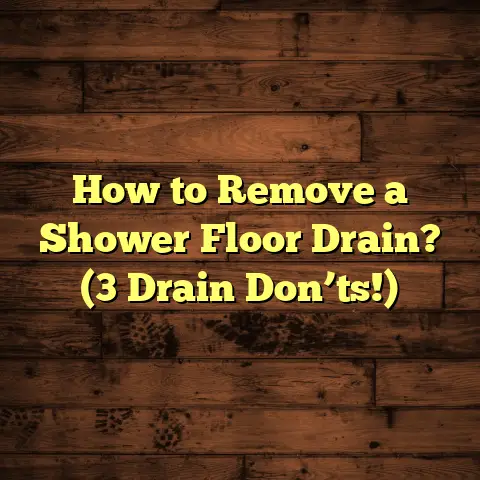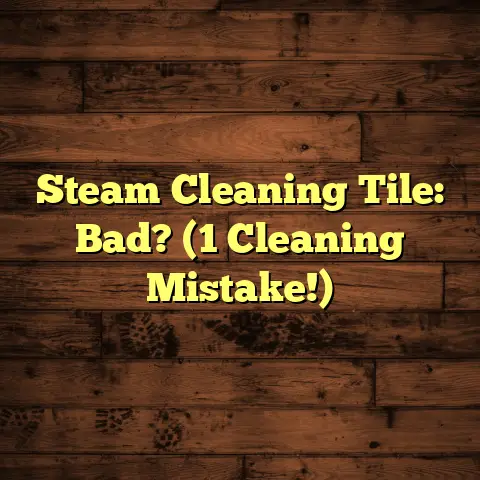Dog Urine Ruin Laminate? (3 Signs!)
One question I get asked all the time is, “Can dog urine really ruin my laminate floor?” The short answer is, unfortunately, yes, it can.
But don’t panic! Today, I’m going to walk you through the signs to look for and what you can do about it. Let’s dive in!
The Benefits of Laminate Flooring in Pet-Friendly Homes
Laminate flooring has become super popular, and for good reason. It’s affordable, looks great, and is relatively easy to maintain.
Plus, let’s be real, who doesn’t want a home that looks stylish without breaking the bank?
One of the biggest reasons I recommend laminate to pet owners is its durability. Laminate is designed to withstand a lot of wear and tear.
It’s scratch-resistant, which is a huge plus if your dog loves to zoom around the house.
Cleaning is a breeze too! Spills and messes can be wiped up quickly, which is essential with pets.
Another great thing about laminate is its ability to reduce noise. Compared to hardwood or tile, laminate has a bit of give, which helps absorb sound.
This can make your home a more comfortable place for both you and your furry friends. No more echoing footsteps or clattering nails!
The Impact of Dog Urine on Laminate Flooring
Okay, now for the not-so-fun part: dog urine. As much as we love our dogs, accidents happen.
And when they happen on laminate, it can be a problem.
Laminate flooring is made of several layers. The top layer is a durable wear layer, followed by a decorative layer (the pretty part that looks like wood or tile).
Underneath that is a core board, usually made of high-density fiberboard (HDF) or medium-density fiberboard (MDF).
This core is where the trouble starts.
When dog urine seeps into the seams or edges of the laminate, it can penetrate the core board.
The core board is highly absorbent, so it soaks up the urine like a sponge.
Once the urine is absorbed, it can cause the core board to swell, warp, and even start to break down.
It’s not just the moisture that’s the problem. Dog urine contains ammonia and other chemicals that can react with the laminate, leading to discoloration and damage.
That’s why it’s so important to address accidents quickly to prevent long-term issues.
The Three Signs Dog Urine is Ruining Your Laminate Flooring
Alright, let’s get to the nitty-gritty. Here are the three main signs that dog urine is ruining your laminate flooring:
Sign 1: Warping and Buckling
One of the most obvious signs of urine damage is warping or buckling. When the core board absorbs moisture, it expands.
Since the laminate is installed in planks or tiles, this expansion can cause the edges to push against each other, leading to warping or buckling.
I’ve seen floors where the planks look like little speed bumps!
How to Identify Warping:
- Visual Inspection: Get down on your hands and knees and look closely at the floor. Do you see any areas where the planks are raised or uneven?
- Touch Test: Run your hand across the floor. Can you feel any bumps or ridges?
- Level Test: Use a level to check for unevenness. Place the level on the floor and see if there are any gaps underneath.
Here’s a real-life example: I once worked on a house where the dog had been consistently peeing in the same corner of the living room.
The laminate planks in that area were noticeably raised, and you could feel the edges sticking up when you walked over them.
The homeowner hadn’t realized the extent of the damage until I pointed it out.
Sign 2: Discoloration and Staining
Dog urine can also cause discoloration and staining on laminate flooring. The chemicals in the urine can react with the decorative layer of the laminate, leading to unsightly marks.
The type of discoloration can vary depending on the type of laminate and the dog’s urine composition.
I’ve seen everything from yellowish stains to dark, almost black spots.
Understanding the Chemistry:
Dog urine contains urea, creatinine, electrolytes, and uric acid. These components can break down into ammonia and other compounds that can stain and discolor surfaces.
The pH of dog urine can also play a role. Typically, dog urine has a pH between 6.0 and 6.5, but it can vary depending on the dog’s diet and health.
More alkaline urine can cause different types of stains than more acidic urine.
Common Color Changes:
- Yellowish Stains: These are the most common type of stain and are usually caused by the pigments in the urine.
- Dark Spots: These can occur when the urine has been left to sit for a long time or when the laminate has been repeatedly exposed to urine.
- Faded Areas: In some cases, the urine can actually bleach the laminate, leading to faded or lighter areas.
I remember one client who had light-colored laminate in her bedroom. Her small dog had been having accidents near the bed, and over time, the laminate developed yellowish stains that were impossible to remove.
No amount of cleaning would get rid of them.
Sign 3: Unpleasant Odors
Lingering odors are a telltale sign that urine has penetrated beneath the laminate surface.
Even if you clean up the visible mess, the urine can seep into the seams and edges of the laminate and get trapped in the core board.
Over time, this trapped urine can start to smell, especially in humid conditions.
How to Determine the Source of the Smell:
- Sniff Test: Get down on your hands and knees and sniff the floor. Pay close attention to the seams and edges of the laminate.
- Humidity Check: Does the smell get worse when it’s humid? This is a good indication that urine is trapped in the core board.
- Subfloor Inspection: If you can access the subfloor (the layer underneath the laminate), check it for signs of urine damage.
I had a client who complained about a persistent urine smell in her house, even though she cleaned religiously.
I lifted a section of the laminate and discovered that the subfloor was soaked with urine. The urine had wicked up into the core board, creating a breeding ground for bacteria and odors.
It was a pretty gross situation, to be honest!
The Consequences of Ignoring These Signs
So, what happens if you ignore these signs? Well, the consequences can be pretty significant.
Extensive Repairs: The longer you wait to address the problem, the more extensive the damage will become.
What starts as a small stain or a slight warp can turn into a major flooring replacement project.
Trust me, replacing an entire floor is much more expensive than addressing the problem early on.
Replacement Costs: Speaking of costs, replacing laminate flooring can be pricey.
According to HomeAdvisor, the average cost to install laminate flooring ranges from \$1,411 and \$2,992, with an average cost of \$2,140.
That’s a lot of money to spend because of a few ignored accidents!
Health Risks: Urine-soaked flooring can create a breeding ground for bacteria, mold, and mildew.
These can release spores and toxins into the air, leading to respiratory problems, allergies, and other health issues.
According to the EPA, mold exposure can cause a variety of health effects, including nasal stuffiness, throat irritation, coughing or wheezing, eye irritation, and skin irritation.
Compromised Home Value: Damaged flooring can also affect the value of your home.
If you ever decide to sell, potential buyers will notice the damaged flooring, and it could deter them from making an offer or lead them to offer a lower price.
Conclusion
Alright, that was a lot of information, but I hope it was helpful!
To recap, dog urine can definitely ruin laminate flooring if left unchecked.
The three main signs to watch out for are warping and buckling, discoloration and staining, and unpleasant odors.
If you notice any of these signs, it’s important to take action quickly to prevent further damage.
Here’s a quick checklist for you:
- Regular Inspection: Check your flooring regularly for any signs of damage.
- Prompt Cleanup: Clean up accidents immediately with a pet-friendly cleaner.
- Professional Help: If you suspect significant damage, call a professional flooring contractor like me!
Remember, your flooring is an investment, and it’s worth taking care of. By staying vigilant and proactive, you can keep your laminate flooring looking great and your home healthy for both you and your furry friends.
Happy flooring!




